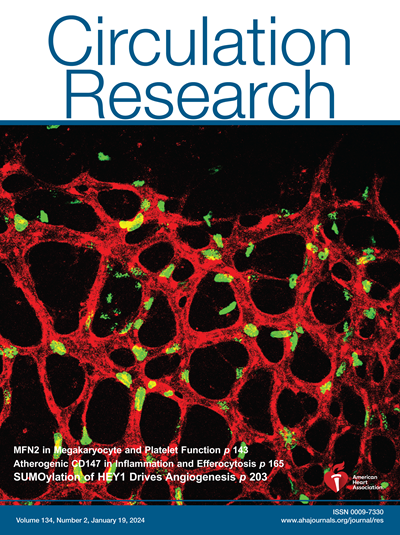环状RNA Cdr1as调节巨噬细胞介导的心脏修复功能。
IF 16.2
1区 医学
Q1 CARDIAC & CARDIOVASCULAR SYSTEMS
引用次数: 0
摘要
巨噬细胞从促炎表型转变为抗炎表型的机制尚不清楚。环状rna是一类新的非编码rna,与免疫调节有关。我们最近发现circ-cdr1as是骨髓源性巨噬细胞表型的调节因子;然而,其在心血管损伤免疫调节中的作用尚不清楚。方法检测心肌梗死后小鼠心肌中circ-cdr1as的细胞特异性表达水平。Circ-cdr1as在荧光标记的骨髓源性巨噬细胞中过表达,并在心肌梗死后立即注射到缺血心肌。测定了AAV9(腺相关病毒-血清型9)介导的circ-Cdr1as全身递送对心肌梗死后心功能和结构的影响。下游机制研究使用增益和功能丧失策略。结果心肌细胞特异性表达分析显示circ-cdr1as仅在巨噬细胞和心肌细胞中显著下调。将circ-cdr1as在骨髓源性巨噬细胞中过表达,注射到缺血心肌中,保留其抗炎表型,显著改善左心室功能,缩小梗死面积。全身递送AAV9-circ-cdr1as显示出类似的心脏修复活性。在机制上,circ-cdr1as直接结合和海绵microRNA-7,并增加靶KLF4 (Kruppel-like factor 4)的表达。功能的丧失和获得研究表明,microRNA 7和KLF的调节再现了巨噬细胞的表型变化。结论scirc -cdr1as通过调控microRNA 7及其靶基因KLF4在巨噬细胞抗炎表型调控中起重要作用。因此,circ-cdr1as在心脏损伤后组织炎症中具有抗炎调节剂的潜力。本文章由计算机程序翻译,如有差异,请以英文原文为准。
Circular RNA Cdr1as Modulates Macrophage-Mediated Cardiac Reparative Function.
BACKGROUND
Mechanisms of macrophage switching from proinflammatory to anti-inflammatory phenotypes are not well understood. Circular RNAs, a new class of noncoding RNAs, are implicated in immune modulation. We recently identified circ-cdr1as as a regulator of macrophage phenotype in bone marrow-derived macrophages; however, its role in immunomodulation during cardiovascular injury remains unknown.
METHODS
Cell-specific expression levels of circ-cdr1as were determined in the mouse hearts postmyocardial infarction. Circ-cdr1as was overexpressed in fluorescently labeled bone marrow-derived macrophages and injected into the ischemic myocardium immediately following myocardial infarction. The effect of AAV9 (adeno-associated virus-serotype 9)-mediated systemic delivery of circ-Cdr1as on postmyocardial infarction cardiac function and structure was determined. Downstream mechanisms were studied using gain and loss-of-function strategies.
RESULTS
Cardiac cell-specific expression analysis showed significant downregulation of circ-cdr1as only in macrophages and cardiomyocytes. Overexpression of circ-cdr1as in bone marrow-derived macrophages, injected into the ischemic myocardium, retained their anti-inflammatory phenotype and significantly improved left ventricular functions and reduced infarct size. Systemic delivery of AAV9-circ-cdr1as showed similar cardiac reparative activity. Mechanistically, circ-cdr1as directly binds and sponges microRNA-7 and increases the expression of target KLF4 (Kruppel-like factor 4). Loss and gain of function studies show that modulation of microRNA 7 and KLF recapitulates macrophage phenotypic changes.
CONCLUSIONS
Circ-cdr1as plays a crucial role in regulating the anti-inflammatory phenotype of macrophages through modulation of microRNA 7 and its target gene KLF4. Therefore, circ-cdr1as holds potential as an anti-inflammatory regulator in tissue inflammation postcardiac injury.
求助全文
通过发布文献求助,成功后即可免费获取论文全文。
去求助
来源期刊

Circulation research
医学-外周血管病
CiteScore
29.60
自引率
2.00%
发文量
535
审稿时长
3-6 weeks
期刊介绍:
Circulation Research is a peer-reviewed journal that serves as a forum for the highest quality research in basic cardiovascular biology. The journal publishes studies that utilize state-of-the-art approaches to investigate mechanisms of human disease, as well as translational and clinical research that provide fundamental insights into the basis of disease and the mechanism of therapies.
Circulation Research has a broad audience that includes clinical and academic cardiologists, basic cardiovascular scientists, physiologists, cellular and molecular biologists, and cardiovascular pharmacologists. The journal aims to advance the understanding of cardiovascular biology and disease by disseminating cutting-edge research to these diverse communities.
In terms of indexing, Circulation Research is included in several prominent scientific databases, including BIOSIS, CAB Abstracts, Chemical Abstracts, Current Contents, EMBASE, and MEDLINE. This ensures that the journal's articles are easily discoverable and accessible to researchers in the field.
Overall, Circulation Research is a reputable publication that attracts high-quality research and provides a platform for the dissemination of important findings in basic cardiovascular biology and its translational and clinical applications.
 求助内容:
求助内容: 应助结果提醒方式:
应助结果提醒方式:


